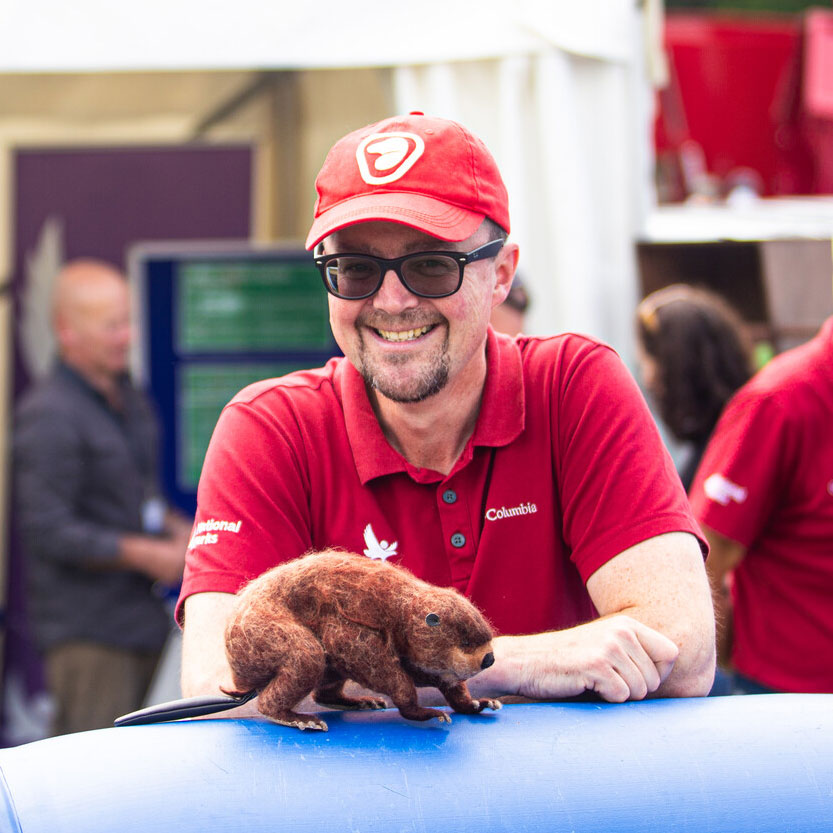Spring beaver diary
I can’t believe it’s already spring again and with the lighter evenings I have been down to the Lily Loch to try and spot some beaver activity. One evening last month just half an hour before dark, my patience was rewarded as a ripple in the water caught my eye and up popped a head with a pair of fluffy ears! At this point, it is possible that the females released over the last two years are pregnant, so we will be eagerly keeping a watch on the lodges over the summer hoping to see kits (baby beavers) taking their first swim in June or July.
At the end of March we said goodbye to Rhona and Emily, our beaver rangers, after a busy few months. As well as keeping up with regular monitoring on site visits, and getting stuck in to any mitigation that was necessary, they have reviewed all the camera trap footage of the beavers (and anything else that wandered in front of the cameras!). We look forward to sharing some of their favourite clips in the weeks to come – keep an eye on our socials for more.
We’re delighted that Pete Short has joined us as our new Beaver Project Officer. He started last month and is already bringing new skills to the project, including drone piloting! He has taken some great pictures giving a whole new perspective on the beaver sites. It’s going to be really interesting to see these over time, as we build an understanding of how the beavers are changing the environment around them.
A few weeks ago I got wind of a felled tree on the Dulnain and so checked it out to see if it was the work of beavers. It had been cut by a saw, but I did spot some beaver gnaw marks on a nearby rowan tree. There were no other beaver signs for 100 metres either side – despite there being plenty of willows – and I contacted the landowner to say we would investigate further. Pete and I walked from Dulnain Bridge to the Spey and only found one more sign of a small willow branch that had been bitten off. This points to the likelihood that a beaver had just been passing through, which was confirmed a couple of weeks later when we heard that a beaver had been sighted in Fochabers (outwith the National Park) nearly 50 miles downstream! There had been a period of high water which would have helped the beaver make the journey. Staff at the Park Authority have since met with landowners and ghillies in the area to answer their questions, address some of their concerns and share more information about the species.
Under the terms our licence from NatureScot, we have permission to release five more pairs or families of beavers into the upper Spey catchment. Pete, myself, and the team are now hard at work scoping the suitability of different locations and working with landowners to prepare for these releases.
On a final note, you may remember that in my last blog I reported the presumed death of a beaver kit that had been separated from its family and spotted near Nethy Bridge back in November. Now in January I got a message that a beaver had been sighted near Cromdale, living in a pond… I visited the site, trail cameras in tow, and after a couple of days we saw the footage and lo and behold it was the missing kit! At just seven months kits usually haven’t learned all the skills they need to survive on their own, but this one, now affectionately known as ‘Lazarus’, seems to be thriving. She found the perfect pond and seems very content. In a year or so she may seek out a mate or one may find her, only time will tell.
This year, seven of the beavers will be two years old which is when they leave their parents and seek out new territories and mates. This means beavers will be moving around more so do keep your eyes peeled for fresh beaver signs (willow trees close to water are their favourite!) and if you see something, drop us an email at [email protected]
